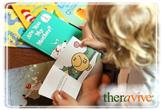October 16, 2013
by Ashley Marie

When it comes to someone with obsessive-compulsive behaviors, the line between enabling and acceptance can be blurred. Here are some valuable insights into helping someone you love who may exhibit OCD.
[More]
October 2, 2013
by Christie Hunter

Hold the psychotropic drugs! Some children diagnosed with ADD and ADHD may be exceptionally gifted. Many are lost through the cracks, don't let it be yours.
[More]
September 21, 2013
by Christie Hunter

A parent's deepest fears exposed. The Peeping Tom no longer needs to sneak outside our windows, he is IN them. There is something we can do to keep them out and our children's dignity and virtue safe from on-line harm.
[More]
September 20, 2013
by Christie Hunter

September is Childhood Obesity Month, and we're going straight after it. It's time to stop the excuses and tackle this epidemic head on. If you have a young child who is overweight, lets work together and change course. We will help you.
[More]
September 16, 2013
by Christie Hunter

A crisis in our educational system is the mis-diagnosis of developmental delays. Why your ADD or ADHD child may be more advanced than your educators think.
[More]
August 30, 2013
by Cindy Marie Hosszu

Back to School Series:
Technology and the internet have changed how we communicate, how we learn, and how we take care of business. It has given us new ways to create, and experience the world around us. Unfortunately, some of the ways we have used technology to evolve are very negative. In the 2008/2009 school year, 20% of students experienced bullying by electronic means, and 28% experienced threat of violence through electronic means. [1] To protect our kids, we must be aware of cyberbulling, and how to prevent it.
What Is Cyberbullying
Cyberbullying is aggressive behavior that is unwanted, repeated, and involves a real or perceived imbalance in power that takes place on electronic devices or media, such as computers, cell phones, social media sites, text messages, chat, web sites, and online gaming. It is bullying between children, not adults. When adults get involved it becomes cyber-harassment, cyber-stalking, or sexual predator behavior.
How Is Cyberbullying Different Than Traditional Bullying
24/7- Cyberbullying can happen any time day or night. Although most cyberbullying is accompanied by in-person bullying, it is harder to avoid because it is not something you can remove or avoid.
Anonymously- Cyberbullying can be posted and distributed very quickly to a large audience, and can be hard or impossible to trace.
Permanent- Once something has been posted on the internet, it is difficult to have it removed.
By Proxy- Cyberbulling can be direct, or by proxy. Anyone can create a profile of the person being targeted to impersonate them and incite others. Others can then use bullying behavior because they think that the target started the behavior. It can be used as a means of punishment from parents, other kids, and even other groups. An example of cyberbullying that involves other groups is when someone posts on hate or sex sites and gives out personal contact information about the target.
Effects of Cyberbullying
Just like traditional bullying,(You can learn more about traditional bullying) kids who are cyberbullied are more likely to use alcohol and drugs, skip school, experience in-person bullying, are often unwilling to attend school, receive poor grades, have low self-esteem, and have more health problems.[2]
Prevent Cyberbullying
Parents and kids can work together to prevent cyberbulling by keeping lines of communication open.
Talk to kids about what cyberbullying is and what to do if they see it.
Establish rules about computer use, and keep the computer in an area of the house that has high visibility.
Make rules with regard to device use so that parents are able to view all online activity and texts at any time. Reassure kids that, as a responsible parent, it is about safety, not invading their privacy. Installing software to monitor online behavior is helpful, but not as effective as monitoring personally.
Know the sites your child visits, who they are with and what they do online.
Follow your kids on social media, and get a feel for the web sites they use.
Teach kids about online safety, such as what to post and how someone may perceive their posts and activities. Only “friend” real friends. Teach them how to know who can see and how to control who can see their posts and activities. Never share user-names, passwords, or location on any web sites.
What To Do If You See Cyberbullying
Never respond to or forward cyberbullying, but do keep any evidence of cyberbullying. Be sure to capture dates, times, and descriptions of cyberbullying by printing screenshots, email or text messages. You can use this record to report to the proper channels.
Block the person doing the cyberbullying.
Look for terms of service for the media, and follow their instruction for reporting so that they can take action.
Report cyberbullying to law enforcement whenever there are threats of violence, child pornography, or explicit messages or photos, stalking, or hate crimes, or if a picture is posted of someone in a place that they would expect to be private.
Let schools know about the bullying. Often times, schools cannot take action directly, but they can help by being aware of the situation. Also, some states require that schools have anti-bullying policies included in the schools handbooks so that it is contractual, and they can take action.
Counseling can help both parents and kids with the stress of cyberbullying.
[1] "Student Victimization in Schools." National Center for Education Statistics (NCES) Home Page, a part of the U.S. Department of Education. Institute of Education Sciences, Nov. 2011. Web. 4 Aug. 2013.
[2] "What is Cyberbullying | StopBullying.gov." Home | StopBullying.gov. N.p., n.d. Web. 4 Aug. 2013.
[3] http://www.dosomething.org/tipsandtools/11-facts-about-cyber-bullying
August 27, 2013
by Ashley Marie

Back to School Series:
I distinctly remember loving story time with my mum but dreading story time with our elementary school librarian.
With mum, I could snuggle up next to her on the living room sofa, drink a cup of hot chocolate, watch her face light up as she neared the climax of the story, and lose myself in the magic of the moment.
But with our librarian, I had to sit on a hard floor, listen to a monotonous story read aloud by a strange lady with a stiff lip, and make sure not to budge for sixty painful minutes.
So, what’s the difference between these two scenarios?
1. Find Books that Your Child Loves
Mum knew how to make it an enjoyable experience, and my librarian didn’t have a clue.
My favourite books as a child were The Chronicles of Narnia by CS Lewis. Mum had a natural gift at making the story come to life as Lucy walked through the wardrobe and into the mysterious land of Narnia, where she stumbled upon the whimsical Mr Tumnus.
Our librarian, however, thought it was a good idea to read about the rustic lives of cowboys in southern Texas – a topic that seemed like an utter bore to a nine-year-old girl clothed in a dainty pink dress and a flowery headband.
Simply put, children will do what interests them, including reading or listening to books that they actually enjoy.
As argued by Reifman, children enjoy books more when they are related to their interests.[1]
One of my younger cousins is fascinated by dinosaurs. Ever since I can remember, she has been able to cite more classifications of dinosaurs than I will ever be able to. When you walk into her bedroom, you see the shelves stacked with dinosaurs and, yes, books on dinosaurs that have been torn at the edges from overuse.
By contrast, my boyfriend spent his childhood years pouring into military history. He turned his bedroom into a military battle, which no one was allowed to touch – he wouldn’t dare reenact an anachronistic version of the events.
We all have unique interests, so let your child fall in love with his or hers. Instead of purchasing the books on your own, take them to the closest Chapters or Barnes & Noble. Maybe even treat them to a Starbucks hot chocolate – a perfect treat to accompany the first pages of their new book.
2. Make Reading a Shared Activity
Reading can also be a group activity. There is a beautiful scene in You’ve Got Mail that displays a picturesque version of how enjoyable shared reading can be. Kathleen Kelly (played by Meg Ryan) is the owner of a charming bookshop called The Shop Around the Corner. In the film, she refers to herself as the Storybook Lady, who routinely offers storytelling sessions to children in the neighbourhood. Flaunting a fairylike hat, she captivates the imagination of her young little audience.
You don’t need to wear a fairylike hat to make reading enjoyable for your child. But be creative. After all, reading is about letting your and your child’s imagination come to life.
Mascott also points out that shared reading is a great opportunity to dialogue with your child.[2] Children’s stories are often packed with morals, so it might be a good idea to help them develop their understanding of life, of right and wrong, of how one bad decision can snowball into an utter disaster, among other life lessons.
3. Encourage Them To Read Out Loud
As discussed by Johnson, some children come to hate books because they hate reading out loud.[3] If you have more than one child, it might a good idea to encourage the older sibling to practice reading out loud to the younger one.
I recall the day that my youngest sister suddenly interrupted a story that I was reading to her. To my surprise, she started reading it herself. I was speechless. But something happened in that moment. Though I did not realize it at the time, my love of reading had been passed down to my youngest sister. She realized that she too could join in on the fun.
4. Reading and Parenthood
Reading is not only a great way to help your child develop an academic skill. It also offers an opportunity for parents and children to connect, bond, and interact. The mental health of a child is intricately connected with the health of family dynamics. If you feel that your family is struggling with communication or the emotional health of your family may be at risk Family Counseling may be a great answer to equip you for the future.
Instead of trying to keep your child out of trouble by putting him or her in front of a TV screen, consider spending 20 minutes or so together – just you and your child, reading a book.
It might seem like an old-fashioned idea for the 21st century, but it is nonetheless a delightful way to spend an evening.
I will always be thankful for the stories that Mum read to me – much more than I am for PlayStation or the Cartoon Network.
[1] Reifman, S. 2011. 7 Ways to Encourage Reluctant Readers. [online] Available at: <http://www.stevereifman.com/featured-articles/for-parents/172-7-ways-to-encourage-reluctant-readers>
[2] Mascott. A. 2013. What to Do You’re your Children Hates Reading. PBS. [online] Available at: <http://www.pbs.org/parents/education/reading-language/reading-tips/what-to-do-when-your-child-hates-reading/>
[3] Johnson, L. 2013. 10 Reasons Nonreaders Don’t Read – And How to Change Their Minds. Scholastic. [online] Available at: <http://www.scholastic.com/teachers/article/10-reasons-nonreaders-dont-read-mdash-and-how-change-their-minds>
August 21, 2013
by Ashley Marie

WEDNESDAY WISDOM
Our world has been shaped by the brilliance of both male and female minds. Notable men include Sir Isaac Newton, Albert Einstein, Leonardo da Vinci, and Sigmund Freud. And notable women include Charlotte Brontë, Margaret Thatcher, Barbara Walters, and Caroline Herschel.
However, it remains a relatively taboo question to ask whether there are differences between the male and female brain. And this fear is not to be belittled. We face concerns about the mistreatment of women in the workplace, as well as abuses stemming from prejudices against another gender. These issues can produce a power imbalance between men and women, and this has historically been problematic for women.
But the above question should not be dismissed, as answering the question can help us understand the advantages of both sets of brains. This article will analyze the differences between male and female brain structures and then explore two areas in which men and women show distinct cognitive differences.
Differences in Brain Structures
The adult brain consists of approximately one hundred billion neurons and typically weighs between 2.25 and 3.5 pounds of dense matter.[1]
The brain has three principal layers.
The first of these is the brain stem, which is the bottom layer. This part of the brain is connected to the spinal cord. The brain stem is more primitive, as it is responsible for our instincts and our responses to immediate crises. Male brains tend to activate this part of the brain more often than women, which is why they are more likely to respond physically in cases where they feel threatened.
Secondly, the limbic system is the middle layer, which is where emotions are processed. The amygdala is part of the limbic system, and this tends to be larger in males, making them typically more aggressive than females.
Thirdly, the cerebral cortex is the top layer, which is where we use our cognitive skills. The left side is responsible for language skills. The right side is responsible for spatial skills, including mathematics. The following section examines both of these cognitive functions, which are especially different for men and women.
Language: Women Take the Lead
There are differences between male and female brains at a mere 26 weeks of pregnancy.[2] Scientists have found that the corpus callosum – a bundle of nerve tissues that connect the left and right parts of the brain – is actually thicker in female fetuses than male fetuses.
Dr Denckla from the Kennedy Krieger Institute, concludes that women have language functions in both the left and right hemispheres of the brain. This means that when women take part in a language-based activity, such as reading a poem, they use both sides of the brain. Men, however, only use the left side.
Similarly, Dr Geary from the University of Missouri claims that the way our brains are shaped affects the skills that we tend to enhance.
Fine motor skills associated with language learning, such as handwriting, tend to mature in girls six years prior to boys.
Jane Austen, Emily Dickinson, Margaret Atwood, Toni Morrison, and Harriet Beecher Stowe are just a few examples of women who displayed a talented fluency in the written language.
Of course, these scientific findings do not mean that men are incapable of refining their language skills to produce brilliant works. Bookshelves also boast an array of notable male writers, such as William Shakespeare, Charles Dickens, Ernest Hemingway, Mark Twain, and F. Scott Fitzgerald. The above findings simply suggest that women display an advantage in language functions, especially during early developmental stages.
Mathematics: Men Take the Lead
Studies have shown that male students display a greater facility than females when it comes to learning mathematics. A study involving 500 male and female children showed that the areas of the brain responsible for mathematic skills tend to mature in boys four years prior to girls.[3]
According to Baron-Cohen, the male brain is better equipped to develop the ability to systematize – i.e. to figure out how things work, such as a car, a military unity, or a computer. This also involves the ability to predict how a specific action will produce a certain result.
Famous male mathematicians include Pythagoras, Andrew Wiles, Wilhelm Leibniz, René Descartes, and Leonhard Euler.
Again, this does not mean that there are not also notable female mathematicians. Women of note in this domain include Hypatia, Sophie Germain, Ada Lovelace, Sofia Kovalevskaya, and Emmy Noether.
Parenthood and a Child's Cognitive Development
Because of the differences between male and female brains, especially during early stages of development, it is important for parents and teachers to recognize how to help children maximize their learning skills.
Typically, girls might require more assistance in mathematics, while boys might require more help with handwriting or the written language.
As shown through examples of brilliant minds throughout the course of the human story, both men and women are capable of pursuing their areas of interest – regardless of their brain structures. This is the beauty of the human brain: it is embedded with enormous potential, as it can be enhanced and refined throughout our lives.
What does this all mean?
As with most things in life, nothing is black and white. Sometimes the confusion that lies in issues such as parenting or even in your own understanding of work tasks can put a lot of stress on us. Working in a field where your brain just might not be best suited can challenge you in ways you may not have anticipated. Sometimes this stress can build up and we may need to see additional help. A counselor can help to dissect the issues in ones life and help to give coping tools for daily life. Sometimes we may need to seek a new career which may be better suited for our own personal gifts and talents. A career counselor can help to work on this which can lead to more satisfaction in your life and even improved relationships. Here is an article which may be able to equip you better with these possible transitions.
Male or Female we have the brain we have so let's begin to work with it and adapt as we need to.
[1] Gurian, M. 2011. Boys and Girls Learn Differently! A Guide for Teachers and Parents. San Francisco: Jossey-Bass Books.
[2] How Male and Female Brains Differ. 2013. WebMD. [online] Available at: http://www.webmd.com/balance/features/how-male-female-brains-differ
[3] Ibid.
August 19, 2013
by Ashley Marie

Bullying is a concern for parents, teachers, and children. And this challenge is becoming evermore complex as traditional bullying behaviours are taking new forms on the Internet.
School will be in session again.
Mothers are scanning flyers from department stores to snatch the latest deal on school supplies. Fathers are planning their morning and afternoon pick-up and drop-off schedules. Girls are picking out their outfit for the first day of school. Boys are gearing up for soccer tryouts.
And bullies are cracking their knuckles.
Bullying is no small challenge, and its harmful effects span across North America.
As discussed in the news this past week, Rehtaeh Parsons, a high school student in Nova Scotia, attempted suicide and passed away this year after a series of incidents of cyber bullying. The perpetrators distributed multiple photos of her online and physically raped her.
In Canada, 1 in 3 students are bullied during the academic year.[1] Sadly, of 35 countries that were studied internationally, Canada had the 9th highest rate of bullying for students at the age of 13.
In the United States, bullying has increased over the last decade.[2] Researchers estimate that 1 in 5 students are bullied over the course of an academic year, and 8% of students report to have bullied others.
Bullying Defined
Bullying involves a perpetrator who intends to harm its victim(s) emotionally and/or physically.[3] Moreover, it includes repeated incidents of emotional and/or physical aggression and is characterized by a power imbalance between two or more individuals.
According to the Canadian Council on Learning, bullying can be broken down into four broad categories: (1) physical bullying, (2) relational bullying, (3) verbal bullying, and (4) electronic bullying.[4] The last of these is a recent phenomenon that is becoming evermore dominant.
Cyber Bullying
Cyber bullying involves online forms of aggression, such as forwarding private photos or information of the victim or writing malicious comments directed at the victim on social networking sites.
Typically, there are more female than male victims of cyber bullying.
In Canada, 73% of victims of cyber bullying reported receiving aggressive emails or instant messages.[5]
In the United States, 1 in 5 teenagers has been cyber bullied and approximately the same number of teenagers have been a cyber bully.[6] Studies show that there is frequently a relationship between online and in-person bullying. Cyber bullying tends to contribute to social exclusion for female victims and tends to result in physical bullying for male victims.
It Often Starts At Home
Researchers have found that the issues that trigger bullying often stem from family dynamics at home.[7] Parents who do not provide a caring environment can harmfully affect their children, who in turn express their discontentment at school. Once the pain of life at home reaches a breaking point, children are more likely to act aggressively towards others.
It Usually Happens at School
Though the triggers that produce bullying behaviour tend to begin at home, the act of bullying typically occurs at school. Studies show that bullying occurs most prominently during recess and in the classroom.[8] Children commonly find their social life at school, so incidents of bullying are more likely to occur on school grounds.
In addition, bullies commonly seek a wider audience to which they can display their power over another. This is especially the case when teachers or supervisors are not present. For instance, schoolyards often lack sufficient supervision, making it easier for bullies to act aggressively towards their victim(s) without any punishment.
How Parents Can Help a Victim of Bullying
Though children do not always tell an adult about incidents of bullying, those who do tend to turn to their parents for help. In fact, 1 in 3 children turn to their mother or father.[9] This is a great time to asses how life for your child is in general- how is their self esteem etc. A Family Counselor can help to assist in communication with your children and working through issues you may not feel confident tackling.
But for those parents whose children have remained silent, these are some warning signs to look out for: unexplained scratches or bruises, unexplained damaged belongings, fear of walking to school or home from school, unpredictable mood swings, anxiety, poor academic performance, and having few friends.
How Parents Can Help a Perpetrator of Bullying
Once an incident of bullying has been identified, the family of the perpetrator of bullying should be notified. Because bullies commonly grow up in dysfunctional families, researchers recommend that schools involve their parents in the process of preventing future incidents of bullying. When parents must commit to actively helping their child, the positive result can be more sustainable in the long run. There are lots of stresses for Parents with back-to-school coming, to get some perspective on this read more here.
Increasing Awareness About Cyber Bullying
In the digital age that we live in, it is also important to help children navigate online social interactions. Social media sites and online forums are often the arena in which modern forms of bullying take place. Parents and teachers can educate children about proper online etiquette and inappropriate behavior. If the triggers of bullying behavior are stopped at home and in the classroom, then we can help decrease incidents of bullying overall.
[1] Canadian Bullying Statistics. 2012. Canadian Institutes of Health Research. [online] Available at: <http://www.cihr-irsc.gc.ca/e/45838.html>
[2] Bullying and Adolescent Health. 2011. Office of Adolescent Health. [online] Available at: <http://www.hhs.gov/ash/oah/news/e-updates/eupdate-7.html>
[3] Bullying in Canada. 2008. Canadian Council on Learning. [online] Available at: <http://www.ccl-cca.ca/pdfs/LessonsInLearning/Mar-20-08-Bullying-in-Canad.pdf>
[4] Ibid.
[5] Canadian Bullying Statistics. 2012. Canadian Institutes of Health Research. [online] Available at: <http://www.cihr-irsc.gc.ca/e/45838.html>
[6] Bullying and Adolescent Health. 2011. Office of Adolescent Health. [online] Available at: <http://www.hhs.gov/ash/oah/news/e-updates/eupdate-7.html>
[7] Rigby, K. 2007. Bullying in Schools and What to Do About It. Victoria, Australia: Acer Press.
[8] Ibid.
[9] Ibid.
August 10, 2013
by Cindy Marie Hosszu

It is not always just about the kids...back to school help for parents:
Back to school time can be very stressful for both children and parents. Parents want their kids to be happy and healthy, and get along well in school. After days of staying up late, sleeping in, and no homework, it can be tough to get back to a routine. Add to that the stress of the $8.5 billion that the United States spent on school shopping in August 2012, and the tension is even higher. [i] However, there are some things you can do to help ease the stress, and send the kids off to school with confidence.
Be Prepared
Don’t wait until the last minute. Create a schedule and do a trial run before school starts. This will give you an idea of how long the morning routine will take, and what types of things can be done in the evening instead of mornings. Make lunches, iron, set out clothes, and pack the backpacks before bed, and you will cut out valuable morning time.
Practice bus routines. Meet the neighborhood kids before the first day, so that your child knows who they will spend the ride with, and it will make it easier to find the right bus after school because they know who to look for on the bus. Plan play dates prior to school so that the kids will know each other and the ride to school will put them at ease before they get to school.
Visit the school. Meet the teachers, know what is expected, get teacher contact info, and a get school supply list. Meeting the teachers will help you decide what types of things are going to be priorities, and what you may need to watch for during the school year. It can also ease the child’s fears if they do not know the teacher, or are unfamiliar with the school layout. Inquire about fees, such as lunches, class fees, art fees, etc. This will allow you to plan your budget.
Gather information. Know the school web site, know the contact information for principal, superintendent, and phone numbers for administration such as the number to call when your child is ill, or you have questions about events. Know how the school communicates important information such as school closures, or late starts, and emergency routines.
Get to bed early several nights before going back to school. We tend to stay up longer as the sun stays up longer. Our bodies need time to adjust back to the fall season. Give yourself a couple weeks to adjust to going to bed early. Start about a half-hour earlier, and gradually add more until you have reached the desired fall bedtime. If you find it difficult to get the kids to adjust, use relaxation techniques such as a warm bath, stories, or other quiet time activities before you put them to bed.
Create a budget, and know how much you can spend for all school related expenses. Differentiate between needs and wants, and do your shopping as close to that first day as you can. Kids always seem to have growth spurts during the summer, and shopping early may mean you will be shopping again early in the year. Discuss with your child, prior to shopping, the types of things you are going to get, and stick to it. If you choose to get 5 new shirts, and 5 new pants, the child knows the expectation and will feel content with what they get.
Designate a desk area. Homework comes first, so make sure there is a place where the kids have all their supplies, quiet, and a posture of study.
Make Family Time
Don’t take on extra tasks during this time. The back to school mad dash is enough stress. Don’t over-stimulate yourself by taking on too much. Stick to your priorities. Remember that kids can be overwhelmed also, and they will need their sleep, and healthy life-style. Be aware of how they are feeling.
Ask the child about their fears. The best way to diminish worry is to address it. Do not give kids new things to worry about by expressing what you think they may worry about, but ask what they are thinking and what they are excited about as the new school year approaches. Based on what they express, you can address the fears they have.
Establish relaxation for both kids and parents. Start a fun tradition, such as doing something special the day before school starts. I like to take my child out for a juice, or ice cream, and do some last minute light shopping for something simple, such as a belt, or hat. The real purpose is to talk and see what my child is thinking about, but all he knows is that it is super cool to have juice or ice cream with mom, and pick out one last new thing. You could also do a family marshmallow roast in the back yard, or game night. Any activities that will allow for natural conversation and fun will be perfect.
Above all, stay positive. We make it through each new school year, and our kids see the little cues we give off if we are tense. Remember that this can be an exciting time to watch our kids grow, and develop into the wonderful new person that they are becoming. Relax and enjoy the pride you have in your amazing kids.
Getting Help:
It is okay to be stressed out. It is normal to be worried about getting everything right and feeling rushed for time. You, as a parent, may benefit from talking to someone about how you are feeling. Counseling to assist in making you the best parent you can be can be helpful. The back to school time can be stressful on your marriage or even work. Therapy can help to relieve the added tension and can help bring back some balance and perspective to life during this time. When it seems like it is all about the kids, sometimes it is important to make sure we are taking care of ourselves.
[i] "Monthly & Annual Retail Trade, Main Page - US Census Bureau." Census Bureau Homepage. N.p., 29 Mar. 2013. Web. 28 July 2013.